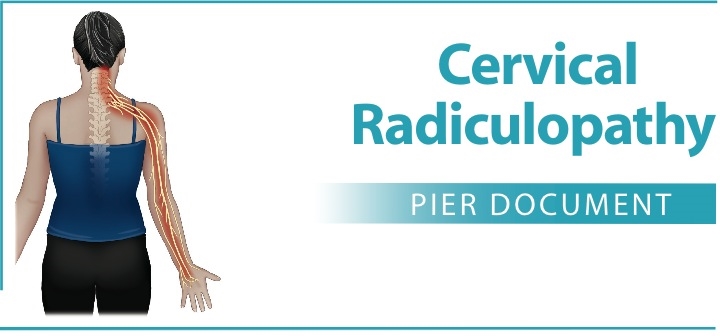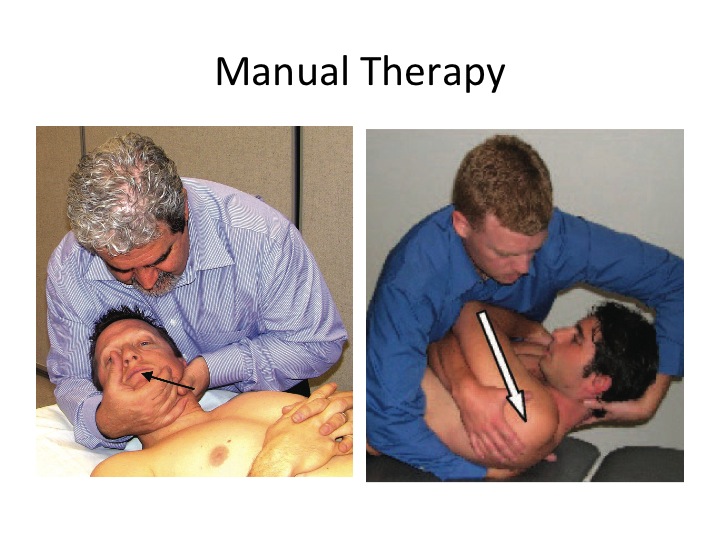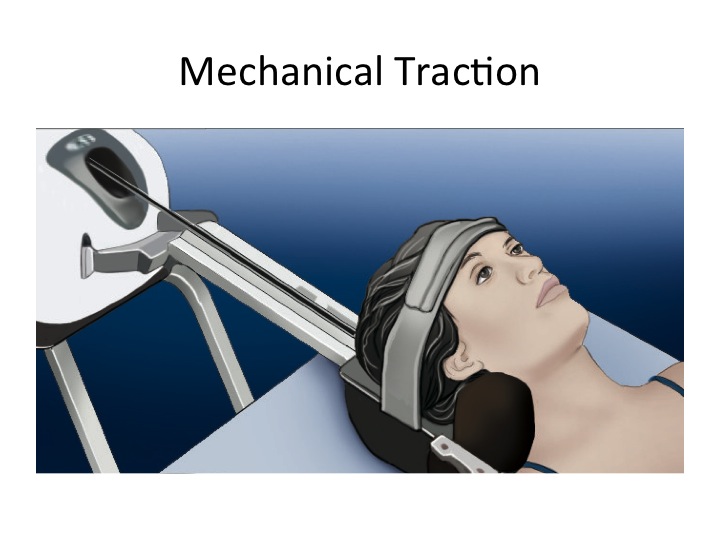Cervical Radiculopathy Injuries and Symptoms
Cervical radiculopathy occurs when a nerve from the neck becomes irritated or compressed by space occu- pying lesion including fluid, soft or bony tissues as it exits the spine. Patients often complain of sharp, burning pain down the arm, numbness, tingling, or weakness.
This condition is most common in the 5th decade of life with an annual incidence of 83 per 100,000 individuals(2).
The C6 and C7 cervical nerve roots are most com- money involved(3). EMG/NCV testing is considered the gold standard for the diagnosis of this disorder.
A clinical prediction rule developed by Wainner et al. showed four clinical tests/measures are helpful for diagnosis of this condition:
1. (+) Spurling’s Test
2. (+) Distraction Test
3. Ipsilateral cervical rotation <60 degrees 4. (+) median nerve upper limb tension test
Authors reported a specificity of 94% and 100% for 3/4 and 4/4 variables, respectively(4).
Physical Therapy Interventions
Recent reviews of cervical radiculopathy suggest conservative treatments may be superior to surgical interventions(5,6).
Authors suggest evidence supports the utilization of short term epidural corticosteroid injections for patients with radicular pain(6).
A multimodal Physical Therapy treatment plan involving manual therapy (joint mobilization/ manipulation and soft tissue mobilization), exercise, mechanical traction, and education provides short and long term reductions in pain and disability.
Physical Therapy Evidence for Cervical Radiculopathy
Literature reviews report the combination of manual therapy and exercise is effective at reducing pain and disability, as well as, increasing AROM in patients with cervical radiculopathy(5).
Cleland et al. demonstrated 91% of patients treated with manual therapy, exercise, and mechanical trac- tion had successful short and long term outcomes(7).
Fritz et al. reported mechanical traction and exercise was superior to exercise or exercise and over the door traction for reducing pain and disability. The group receiving mechanical traction and exercise was the only group to sustain the benefits of the 4 week treat- ment at 6 and 12 month follow ups(1).
Raney et al. suggested four variables may assist in determining which patients will best respond to cervical mechanical traction:
1. Peripheralization with manual therapy testing 2. (+) shoulder abduction test
3. Age >55 years old
4. (+) median nerve upper limb tension test 5. (+) neck distraction test If 4/5 variables are met there was a 95% success rate(9).
When to Seek Physical Therapy Treatment
Patient’s with neck and arm pain with or without symptoms of nerve root irritation including numbness, paresthesias, or weakness should be referred to PT for short and long term reduction of pain and disability.
Health Care practitioners may use Wainner’s CPR noted above for the clinical diagnosis of Cervical Radiculopathy.
Cleland et al. noted four variables help predict patients who will respond favorably to physical therapy interventions for cervical radiculopathy:
1. Age <54
2. Dominant arm not affected
3. Cervical flexion does not worsen symptoms 4. Patient received multimodal PT treatment
A 85% and 90% success rate was found if patients met 3/4 or 4/4 variables, respectively(8).
References
1. Fritz et al. Exercise Only, Exercise With Mechanical Traction, or Exercise With Over-Door Traction for Patients With Cervical Radiculopathy, With or Without Consider- ation of Status on a Previously Described Subgrouping Rule: A Randomized Clinical Trial. JOSPT. 2014;44(2):45- 57.
2. Radhakrishnan K, Litchy WJ, O’Fallon WM, Kurland LT. Epidemiology of cervical radiculopathy: a population- based study from Rochester, Minnesota, 1976–1990. Brain 1994; 117:325–35.
3. Dillin W, Booth R, Cuckler J, Balderston R, Simeone F, Rothman R. Cervical radiculopathy: a review. Spine 1986;11:988–91.
4. Wainner RS, Gill H. Diagnosis and nonoperative manage- ment of cervical radiculopathy. J Orthop Sports Phys Ther 2000;30:728–44.
5. Boyles et al. Effectiveness of manual physical therapy in the treatment of cervical radiculopathy: a systematic review. J Man Manip Ther. 2011. 19(3):135-142.
6. Carragee, E. et al. Treatment of Neck Pain. Injections and Surgical Interventions. Spine. 2008. 33(45):S153-S169.
7. Cleland JA, Whitman JM, Fritz JM, Palmer JA. Manual physical therapy, cervical traction, and strengthening exercises in patients with cervical radiculopathy: a case series. J Orthop Sports Phys Ther 2005;35:802–11.
8. Cleland, J. et al. Predictors of Short-Term Outcome in People With a Clinical Diagnosis of Cervical Radiculopathy. JOSPT. 2007
9. Raney, N. Development of clinical prediction rule to identify patients with neck pain likely to benefit from cervical traction and exercise. Eur Spine J. 2009.



